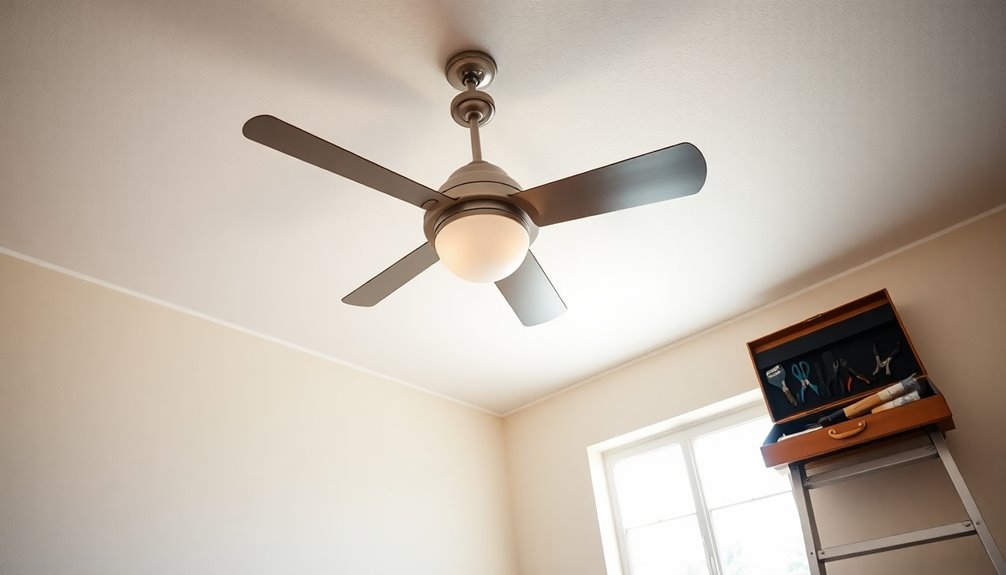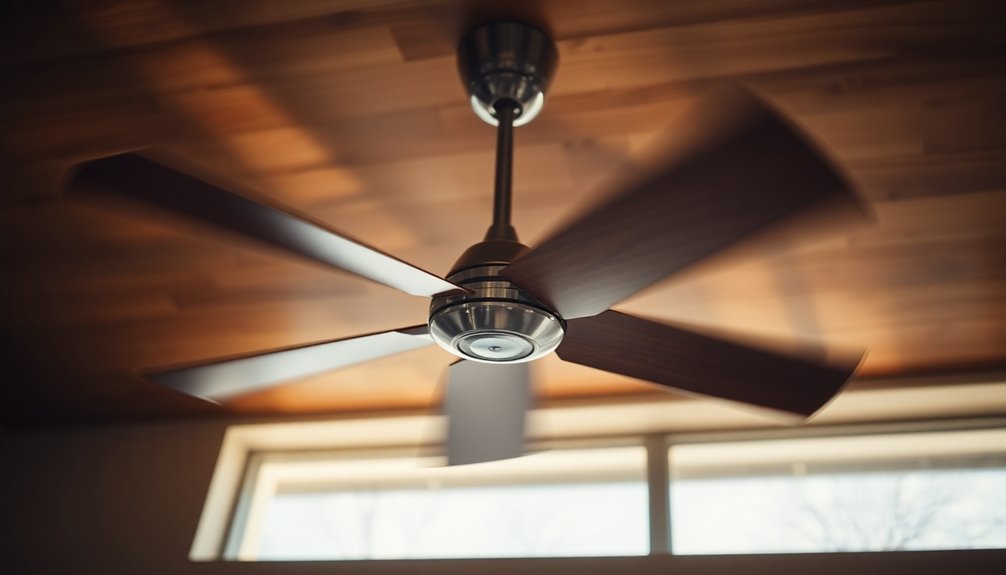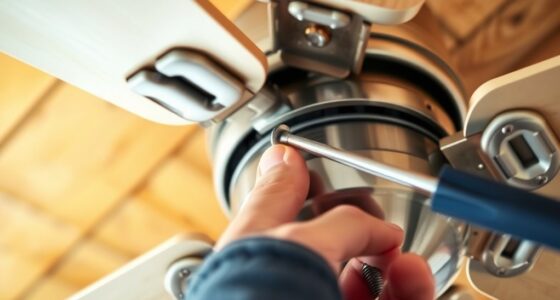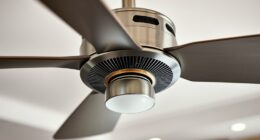If a ceiling fan falls on you, you might suffer serious injuries ranging from bruises and lacerations to fractures or even concussions. Every year, over 19,700 non-fatal injuries occur due to ceiling fan accidents, and some cases can be life-altering. The risk often stems from improper installation, loose screws, or worn-out components. It's vital to guarantee that fans are correctly mounted and well-maintained. If you're affected and have injuries, understanding your rights and potential compensation can be significant. There's more to uncover about preventing these incidents and what steps to take if you're involved in such an accident.
Key Takeaways
- A ceiling fan falling can cause minor injuries like lacerations or more severe injuries including fractures and concussions, depending on the fan's weight and height.
- Approximately 25 fatalities occur annually in the U.S. due to ceiling fan accidents, highlighting the potential severity of such incidents.
- Legal liability may fall on manufacturers, installers, or property owners depending on the cause of the ceiling fan's failure.
- Documenting the incident with medical records and photographs is essential for establishing liability and seeking compensation for injuries sustained.
- Regular maintenance and proper installation are crucial to prevent ceiling fan falls and reduce the risk of serious injuries.
Understanding Ceiling Fan Injuries

When it comes to ceiling fan injuries, the consequences can vary widely. You might experience anything from minor lacerations and bruises to severe injuries like fractures or concussions, depending on the fan's speed and design at the time of impact. Approximately 25 deaths occur annually in the U.S. due to ceiling fan accidents, often happening when people fall while cleaning or repairing these fixtures.
Each year, over 19,700 non-fatal injuries related to ceiling fans are reported, with improper installation and incorrect sizing being significant contributors to these incidents. If a ceiling fan falls, the severity of your injury can depend on various factors, such as the fan's weight and the height of your ceiling, leading to potential crush injuries in extreme cases.
To minimize the risks associated with ceiling fan injuries, regular maintenance and proper installation are essential. Many accidents stem from inadequate safety measures, and understanding the importance of these factors can help you prevent personal injury.
Make sure your ceiling fan is securely mounted and regularly checked to keep yourself and others safe from potential harm.
Causes of Ceiling Fan Falls

Ceiling fan falls can happen for several reasons, often stemming from installation errors or maintenance neglect. One major cause is improper installation, which can involve inadequate support or unsecured mounting brackets. If the fan isn't anchored properly, it may become unstable and increase the chances of a ceiling fan falling.
Additionally, material failure, such as a broken or rusted mounting system, can lead to the fan detaching from the ceiling fixture.
Another factor is the size of the fan in relation to the ceiling height. An oversized fan can create instability, making it more prone to accidents.
Regular maintenance is vital to guarantee your ceiling fan remains secure. Loose screws or worn-out components can compromise its stability, so checking these elements periodically is essential.
Environmental factors also play a role, especially for outdoor installations. High winds or severe weather can stress the fan, leading to potential falls.
To keep your home safe, make sure to follow installation guidelines, perform regular maintenance, and consider the environment where your ceiling fan is placed.
Types of Injuries From Falls

If a ceiling fan falls on you, the injuries can range from minor lacerations to severe fractures or even concussions.
The weight of the fan and the height from which it falls considerably influence the severity of your injuries.
Understanding these potential risks can help you take necessary precautions to avoid such accidents.
Common Injury Types
Falling ceiling fans can lead to a range of serious injuries that you mightn't expect. When a ceiling fan falls, the blades can cause lacerations and bruises, leaving you with painful cuts. The impact from the fan's weight, especially if it's heavy, can result in fractures—most commonly to the skull or limbs.
If you're struck by a fast-moving fan, you might even suffer a concussion, which can have lasting effects on your health. In more severe cases, crush injuries can occur if the fan lands directly on you, damaging bones and soft tissues considerably.
These injuries can be life-altering and may require extensive medical attention. Shockingly, around 25 deaths occur annually in the U.S. due to ceiling fan accidents, underscoring the potential dangers of these household fixtures.
If you experience fan injuries as a result of such an accident, consulting an injury lawyer can be vital for understanding your rights and potential compensation. It's important to recognize the risks that ceiling fans pose, ensuring you take precautions to avoid these unexpected injuries.
Severity of Injuries
Injuries from ceiling fans can vary widely in severity based on factors like the fan's weight and the height from which it falls. Understanding the potential types of injuries can help you grasp the risks involved:
- Minor Injuries: These include lacerations and bruises, often resulting from lighter fans or lower falls.
- Moderate Injuries: You might face concussions or fractures if a heavier fan falls from a greater height.
- Severe Injuries: Crush injuries are possible if the fan lands directly on you, leading to significant trauma requiring immediate medical treatment.
Each year, over 19,700 non-fatal injuries are reported in the U.S. due to ceiling fan accidents, highlighting the real dangers.
The installation height of the fan plays a critical role in injury severity; higher fans pose a greater risk of serious injury upon falling.
Unfortunately, about 25 fatalities occur annually, often related to cleaning or repairing ceiling fans.
Recognizing the severity of potential injuries can encourage you to take precautions, ensuring you stay safe around these household fixtures.
Legal Liability for Injuries

What happens when a ceiling fan falls and causes harm? The question of liability becomes essential. If a manufacturer's defect caused the fan to fall, they may be responsible. Conversely, if improper installation led to the accident, the installer could be held liable. Property owners also face liability if they fail to maintain a safe environment.
To establish liability, you'll need to gather evidence, such as maintenance records, installation documentation, and witness statements. Here's a quick overview of potential responsible parties:
| Responsible Party | Possible Liability | Actions Required |
|---|---|---|
| Manufacturer | Defective product | Legal advice, gather medical records |
| Installer | Improper installation | Document installation details |
| Property Owner | Negligence in maintenance | Collect maintenance history |
If you can establish liability, you might recover medical expenses, lost wages, and pain and suffering. In some cases, punitive damages could be pursued for particularly reckless behavior. Always consider seeking legal advice to navigate these complex situations effectively.
Seeking Legal Remedies

If a ceiling fan falls on you, it's crucial to establish liability to seek compensation for your injuries.
You'll want to collect evidence like medical records and eyewitness statements to support your claim.
Establishing Liability for Injuries
A ceiling fan crashing down can lead to serious injuries, but proving who's liable for those injuries is vital for seeking compensation. Here are three key factors to take into account when establishing liability:
- Manufacturer's Responsibility: If the fan has design or manufacturing defects, you may hold the manufacturer liable under product liability laws.
- Installer Negligence: If the fan was improperly installed, you could pursue a claim against the installer for negligence, especially if their actions contributed to the fan's failure.
- Property Owner Maintenance Duties: Property owners have a legal obligation to maintain safe conditions. If the fan fell due to a lack of maintenance or inspections, they might be liable for your injuries.
To seek compensation for medical expenses, lost wages, and pain and suffering, you'll need to establish liability. This process involves showing negligence on the part of the manufacturer, installer, or property owner.
Gathering evidence, like maintenance records or installation instructions, can be vital. Understanding who's liable is the first step toward recovering damages after an injury caused by a falling ceiling fan.
Collecting Evidence for Claims
Collecting evidence is essential for building a strong claim after a ceiling fan injury. You'll want to gather all relevant medical records to detail your injuries, treatment, and the severity of your condition. This documentation not only helps establish the extent of your medical expenses but also supports claims for pain and suffering.
Next, take photographs of the incident scene and collect witness statements. This evidence can clarify what happened and bolster your case against those responsible.
It's also imperative to obtain proof of the fan's installation conditions, such as maintenance records or installation instructions, especially if you're pursuing a claim against manufacturers or installers for negligence.
Don't overlook any safety violations or warnings ignored by property owners, as this evidence can greatly strengthen your claim.
Types of Damages Available
Once you've gathered evidence to support your claim, understanding the types of damages you can pursue is vital for seeking legal remedies after a ceiling fan injury.
Here are three key types of damages you might consider:
- Medical Expenses: You can recover costs for medical treatment related to your injury, including hospital bills, therapy, and medications. Establishing liability is essential for this claim.
- Lost Wages: If your injury forces you to take time off work, you can claim compensation for lost wages. This can help alleviate the financial burden while you recover.
- Pain and Suffering: You may pursue damages for the physical pain and emotional distress you've experienced due to the accident. The amount awarded varies depending on the specifics of your case.
If negligence or reckless behavior led to your injury, punitive damages might also be applicable, serving as a financial penalty against those responsible.
Understanding these types of damages can help you navigate the legal process and guarantee you seek the compensation you deserve for your injuries.
Importance of Legal Representation

Maneuvering the aftermath of a ceiling fan injury can be overwhelming, making legal representation indispensable for your case. When you face such an injury, establishing liability is essential. A personal injury attorney can help identify whether manufacturers, installers, or property owners are at fault. They'll gather important evidence, like medical records and witness statements, to strengthen your claim for damages.
Navigating the legal complexities of personal injury claims is no small feat. Without a lawyer, you risk missing procedural rules and deadlines that could jeopardize your case. An experienced attorney guarantees compliance, maximizing your chances of a successful outcome. They can also negotiate settlements on your behalf, aiming for compensation that covers medical expenses, lost wages, and pain and suffering.
It's significant to understand the statute of limitations for filing personal injury claims. Legal representation assures that all necessary paperwork is submitted in a timely manner, protecting your rights and interests.
With the right support, you can focus on your recovery while your attorney handles the intricate legal processes involved in your case. Don't underestimate the importance of having skilled legal representation on your side.
Prevention and Maintenance Tips

To keep your ceiling fan safe and functional, regular maintenance is key. By prioritizing prevention, you can avoid potential accidents caused by falling fans. Here are three essential maintenance tips to take into account:
- Inspect for Loose Screws: Regularly check all screws and fasteners. Tighten any loose screws to reduce wobbling and the risk of the fan disconnecting from the ceiling. Ensuring proper airflow around the unit can also help maintain stability.
- Check Blade Condition: Look for bent blades or signs of wear. Damaged blades can cause imbalance, leading to dangerous situations. Regular inspections can ensure that the fan operates efficiently, similar to the maintenance of air purifiers.
- Height Matters: Confirm your ceiling fan is installed at a height of at least 8 to 10 feet from the floor. This height minimizes injury risks if something goes wrong.
Additionally, schedule maintenance checks every six months to thoroughly assess your fan's condition. Regular inspections can help ensure that your ceiling fan operates at optimal efficiency, reducing reliance on air conditioning and ultimately saving energy.
If you're unsure about installation or repairs, think about hiring a licensed electrician to confirm everything is compliant with safety standards.
When to Consult a Lawyer

When a ceiling fan falls and causes injury, knowing when to consult a lawyer becomes important for your wellbeing and financial recovery. If you've sustained injuries due to a falling ceiling fan, especially if it was improperly installed or defective, reaching out to a lawyer should be a priority. They can help establish liability, which is significant for your case.
Documenting your injuries with medical records is essential; this evidence not only supports your personal injury claim but also helps recover medical expenses. Additionally, if your injury prevents you from working, injured parties may be entitled to compensation for lost wages, making legal consultation important to understand your rights.
Engaging a personal injury lawyer early in the process is beneficial. They can assist in collecting evidence, such as witness statements and photographs, which are key for bolstering your claims.
Finally, be aware of the statute of limitations for filing a personal injury claim. Timely consultation with a lawyer guarantees you protect your legal rights and maximize your chances of receiving the compensation you deserve.
Don't hesitate—take action for your recovery today.
Frequently Asked Questions
What Happens if a Spinning Ceiling Fan Falls on You?
If a spinning ceiling fan falls, you're at serious risk for injury. The weight and speed increase the chances of lacerations, fractures, or even concussions.
You mightn't see it coming, especially if you're cleaning or adjusting the fan. It's crucial to guarantee proper installation and maintenance to avoid such accidents.
Regular checks can help you stay safe and reduce the risk of a potentially life-threatening situation from a falling fan.
What Happens if a Fan Hits You?
They say, "What goes up must come down."
If a fan hits you, the impact can lead to serious injuries, like cuts, bruises, or even fractures. Depending on the fan's size and material, the severity of your injuries can vary greatly.
You might experience pain, swelling, or dizziness afterward. It's essential to seek medical attention if you feel unwell, as some injuries may not be immediately apparent.
Staying cautious and vigilant is key!
How Likely Is It for a Ceiling Fan to Fall?
The likelihood of a ceiling fan falling is quite low if it's properly installed. You should confirm it's securely mounted, as most fans are designed to handle normal use and vibrations.
Regular maintenance is key; check for loose screws or bent blades to prevent issues. While accidents do occur, staying proactive with inspections and addressing any wobbling can greatly reduce risks, keeping your living space safe and sound.
Is It Safe to Sleep With a Ceiling Fan On?
Sleeping with a ceiling fan on is like drifting off under a gentle breeze, wrapping you in comfort.
It's generally safe and helps keep your room cool while improving air circulation. Regular maintenance is key, so check for loose screws and listen for odd noises.
If installed correctly, you won't have to worry about it. Plus, research shows it can enhance sleep quality, making your nights more restful and rejuvenating.
Conclusion
In the blink of an eye, a ceiling fan can turn from a comforting breeze to a potential hazard. If you ever find yourself injured from such an incident, remember that you have rights and options. Seeking legal representation is essential to navigate the complexities of liability and compensation. Stay proactive—regular maintenance can help guarantee your ceiling fan remains a source of comfort, not a cause for concern. Your safety is worth the effort to protect.









